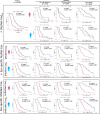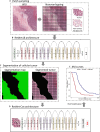Sexually dimorphic computational histopathological signatures prognostic of overall survival in high-grade gliomas via deep learning
- PMID: 39178259
- PMCID: PMC11343024
- DOI: 10.1126/sciadv.adi0302
Sexually dimorphic computational histopathological signatures prognostic of overall survival in high-grade gliomas via deep learning
Abstract
High-grade glioma (HGG) is an aggressive brain tumor. Sex is an important factor that differentially affects survival outcomes in HGG. We used an end-to-end deep learning approach on hematoxylin and eosin (H&E) scans to (i) identify sex-specific histopathological attributes of the tumor microenvironment (TME), and (ii) create sex-specific risk profiles to prognosticate overall survival. Surgically resected H&E-stained tissue slides were analyzed in a two-stage approach using ResNet18 deep learning models, first, to segment the viable tumor regions and second, to build sex-specific prognostic models for prediction of overall survival. Our mResNet-Cox model yielded C-index (0.696, 0.736, 0.731, and 0.729) for the female cohort and C-index (0.729, 0.738, 0.724, and 0.696) for the male cohort across training and three independent validation cohorts, respectively. End-to-end deep learning approaches using routine H&E-stained slides, trained separately on male and female patients with HGG, may allow for identifying sex-specific histopathological attributes of the TME associated with survival and, ultimately, build patient-centric prognostic risk assessment models.
Figures






References
-
- Stupp R., Mason W. P., van den Bent M. J., Weller M., Fisher B., Taphoorn M. J. B., Belanger K., Brandes A. A., Marosi C., Bogdahn U., Curschmann J., Janzer R. C., Ludwin S. K., Gorlia T., Allgeier A., Lacombe D., Cairncross J. G., Eisenhauer E., Mirimanoff R. O., Radiotherapy plus concomitant and adjuvant temozolomide for glioblastoma. N. Engl. J. Med. 352, 987–996 (2005). - PubMed
-
- A. F. Tamimi, M. Juweid, Epidemiology and Outcome of Glioblastoma, in Glioblastoma, S. De Vleeschouwer, Ed. (Codon Publications, Brisbane (AU), 2017); http://www.ncbi.nlm.nih.gov/books/NBK470003/. - PubMed
-
- Lee J., Kay K., Troike K., Ahluwalia M. S., Lathia J. D., Sex differences in glioblastoma immunotherapy response. Neuromolecular Med. 24, 50–55 (2022). - PubMed
Publication types
MeSH terms
Grants and funding
LinkOut - more resources
Full Text Sources
Medical

